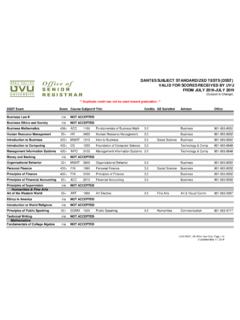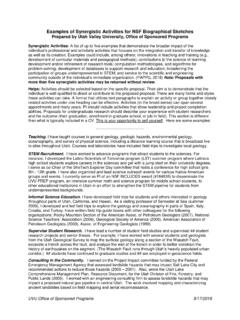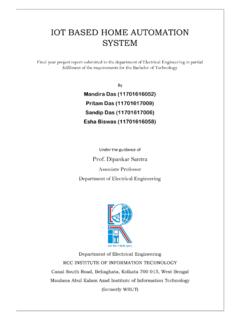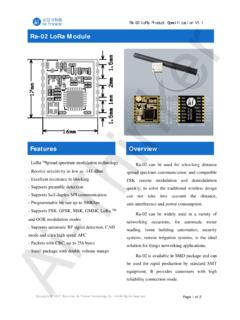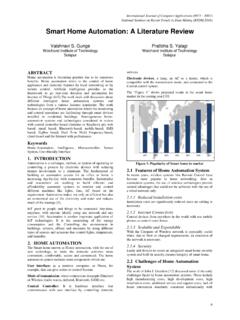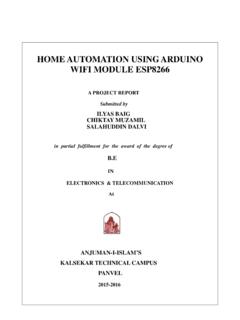Transcription of Letters of Commitment, Collaboration, and Support
1 Office of Sponsored Programs Last updated 10/24/2018 Letters of Commitment, Collaboration, and Support Overview. Many proposals require or allow Letters from your institution, administrators, partners, and collaborators. Some funding organization request Letters of Support or commitment and others do not allow them. The Department of Education, for instance, rarely asks for Letters , and, if included, would count against the proposal page count. The National Science Foundation, on the other hand, requires Letters of collaboration, especially from the proposing institution and project partners, but does not allow Letters of Support .
2 Other funding agencies leave the inclusion of Letters to the proposer s discretion. It is important that proposers understand what is expected by the funder, the difference between the types of Letters , and how to strengthen this aspect of a proposal. The following descriptions explain the general differences among these types of documents: Letter of Commitment indicates the signatory s intent to commit resources to the funded project as specified in the letter, should the proposal be funded. May also give the partner s rationale for supporting the project and point to strengths of the organization that could be of value in implementing or sustaining the project.
3 Letter of Collaboration indicates the signatory s intent to collaborate and/or commit resources as described in the proposal or the letter, should the proposal be funded. Note that NSF now only allows Letters of collaboration (unless otherwise requested) and specifies how they should be written in its Proposals and Awards Procedures and Policies Guide. OSP has a template for the NSF Letters of Collaboration on its website. Letter of Support expresses the organization s knowledge and Support of the project, including why the project is important and how it relates to the organization s mission or expressed goals.
4 May address the proposer s qualifications or abilities to complete the project. Such Letters can add much additional information to strengthen the proposal. Preparing the Letters . The PI should solicit Letters well in advance of the due date so there will be time for signatures. Letters from partners should represent true, collaborative partnerships. These partnerships work best when partners have been involved in the proposal planning and preparation stages so that their concerns and ideas are addressed. It is often useful if you, after conversations with the writer, draft the letter or give the writer a list of talking points of things to include.
5 This is especially important if resources are being committed. Use the following guidelines in preparing Letters : Keep Letters short and to the point. Be specific about the nature of the collaboration or commitment. Usually indicate concrete actions the signer is committed to provide during the project. Do not commit to any dollar amount of funds or resources unless you have permission from OSP (the Program Director of Sponsored Research). Don t use form Letters ; make each letter unique (except for NSF Letters of Collaboration).
6 You might even use different font types or margins. Obtaining Signatures. Proposers requesting Letters should provide the administrator with a copy of the proposal Abstract and, for NSF proposals, the Facilities, Equipment, and Other Resources section. Some deans required the full proposal to be submitted for their review at least a week in advance as well. Please speak with an OSP Program Director if you have questions about who should submit Letters for your project. Office of Sponsored Programs Last updated 10/24/2018 Letters from a UVU Vice President or Dean require a week for approval.
7 Letters from the UVU President, which are rarely requested, require two weeks (10 business days). Letters from business and community partners should have been discussed and agreed to long before the submission date. These may also take up to a week to get approval. Letters must be printed on letterhead paper of the signer s organization, signed, and scanned as a pdf document. The PI should keep a signed original copy of the letter in the event the proposal is funded and audited. A pdf copy will be submitted with the proposal. #################### Example 1 Local Business Letter of Support Eric Luetkenhaus Department of Labor Employment and Training Administration Division of Federal Assistance Washington, DC 20210 Dear Mr.
8 Luetkenhaus I am writing this letter in Support of a proposal for funding for the Mechatronics Engineering Technology discipline that is being proposed by Utah Valley University. Our nation has been losing a large portion of our manufacturing base business to overseas and low labor countries. The economic pressures that this trend has created here in the US are tremendous. Many companies could prevent this inevitable transition if personnel familiar with more high tech automated manufacturing methods were available. Many companies currently rely on automated equipment to Support their efforts of producing products at a higher rate, with better quality for less money.
9 To accomplish this, companies must have technicians trained in the high tech automation and manufacturing disciplines. In my 20 years of automation experience, I have seen very few Colleges or Universities who truly understand and Support this type of discipline. We are constantly looking for talented individuals to fill engineering positions in the automation technology arena. We see a large shortage of graduates who have been taught in this area of expertise. As a result, we are constantly having to provide on the job training to our personnel.
10 It can take years for individuals without experience or training in this discipline to become productive. I highly recommend your Support of this funding and can assure you that companies will greatly benefit from the resultant training and education that students entering this program will provide to company s efforts to save their factories and keep manufacturing jobs here in the Sincerely, John C. Doe Vice President of Sales and Marketing XYZ Systems Inc. Office of Sponsored Programs Last updated 10/24/2018 Example 2 Partner Letter of Commitment and Support Eric Luetkenhaus Department of Labor Employment and Training Administration Division of Federal Assistance Washington, DC 20210 Dear Mr.



